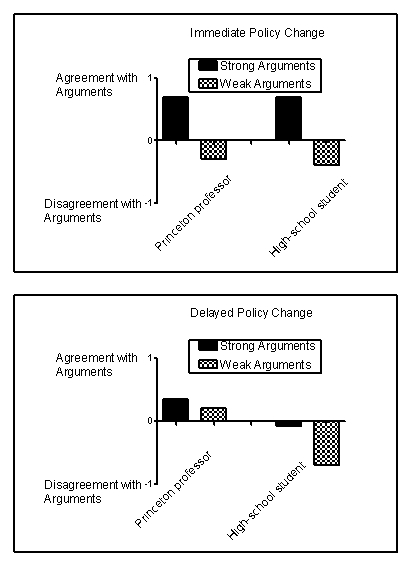Scenario II
The following scenario contains fabricated results consistent with the following study:
Petty, R. E., Cacioppo, J. T., & Goldman, R. (1981) . Personal involvement as a determinant of argument-based persuasion. Journal of Personality and Social Psychology, 41, 847-855.
Every day, consumers are exposed to scientifically based sales, marketing, and public relations strategies designed to influence purchasing decisions, change opinions, or win votes. One common sales strategy is the foot-in-the-door technique, a method that involves first making a smaller request that consumers are likely to grant and then following it by a larger request. Another common strategy is the door-in-the-face technique, which involves making an unreasonably large request that consumers will reject and then following it by a smaller request. When persuasion is necessary, it usually takes one of two forms: heuristic persuasion involves an appeal to habits or emotion, and systematic persuasion involves an appeal to facts and reason. Often, people will rely more on heuristics-simple short-cuts or "rules of thumb"-to make decisions instead of systematically weighing the evidence.
Petty and colleagues (1981) investigated some of these techniques in college students listening to arguments in favor of their college requiring an institution-level comprehensive final examination for graduation. Some students were led to believe that, if adopted, this policy would take place right away, and some were led to believe that the change would take place in a decade. In addition, some of the students were led to believe that they were listening to an argument from a Princeton professor, and others were led to believe that they were listening to an argument from a high-school student. Finally, some students heard strong arguments in favor of the policy, and some heard weak arguments. Thus, the experiment arranged six groups of students. For example, one group of students heard strong arguments from a high-school student about a far-removed policy change. Figure 13.1 shows fabricated results illustrating the major findings of this experiment.
Figure 13.1 
-(Scenario II) Which is NOT an independent variable in the Petty et al. (1981) experiment?
Definitions:
Preferences
An individual's selective liking or desire for one or more choices over others.
Quality Circles
Small groups of employees who voluntarily meet regularly to identify, analyze, and propose solutions to mutual problems, often related to work processes and quality improvement.
Participative Decision Making
A decision-making process where all members of a group are involved in identifying problems and developing solutions, enhancing team involvement and commitment.
Total Quality Management
A management approach focused on continuous improvement of all organizational processes, leading to high-quality products and services.
Q1: Which of these people who have been
Q9: The idea that people behave aggressively when
Q11: Burnout occurs more often in the helping
Q13: Social-cognitive research suggests that those who cheat
Q28: Teenagers who score low on _ are
Q81: A teacher who offers rewards and threatens
Q97: _ disorders are defined as deeply ingrained,
Q105: Presented as a continuum, which Big Five
Q145: Samantha is a first-year college student living
Q191: Pam is very neat and orderly. She